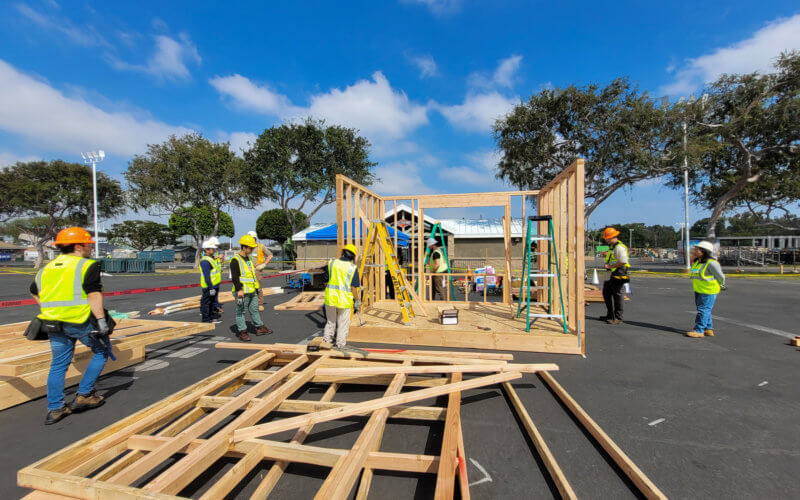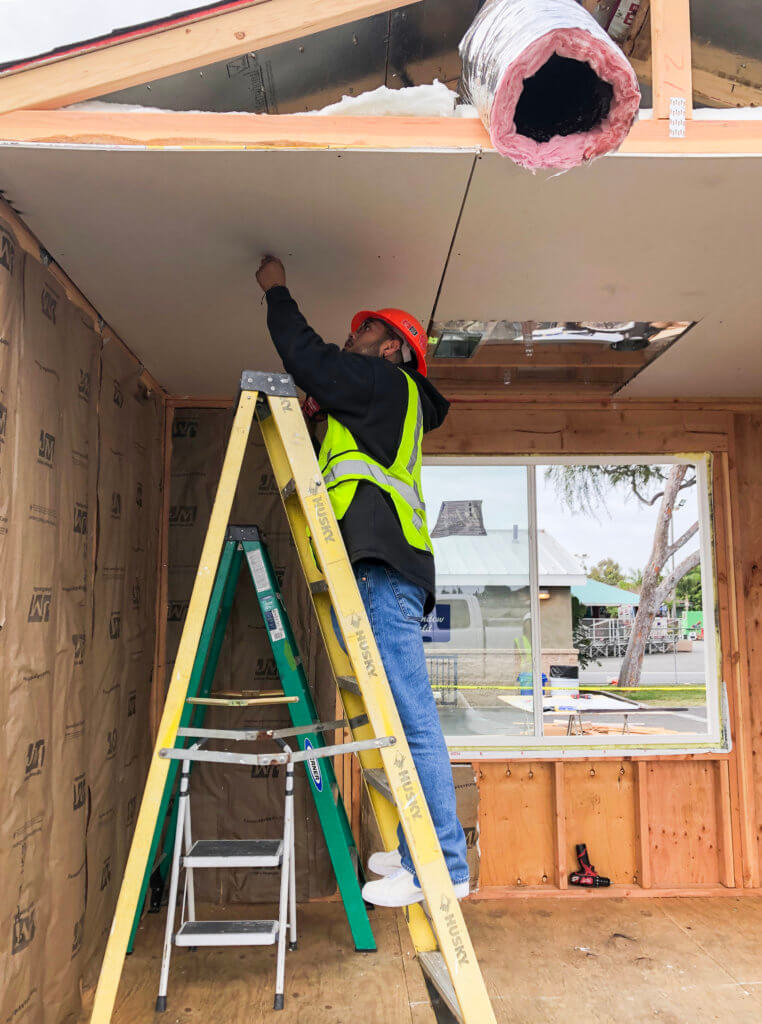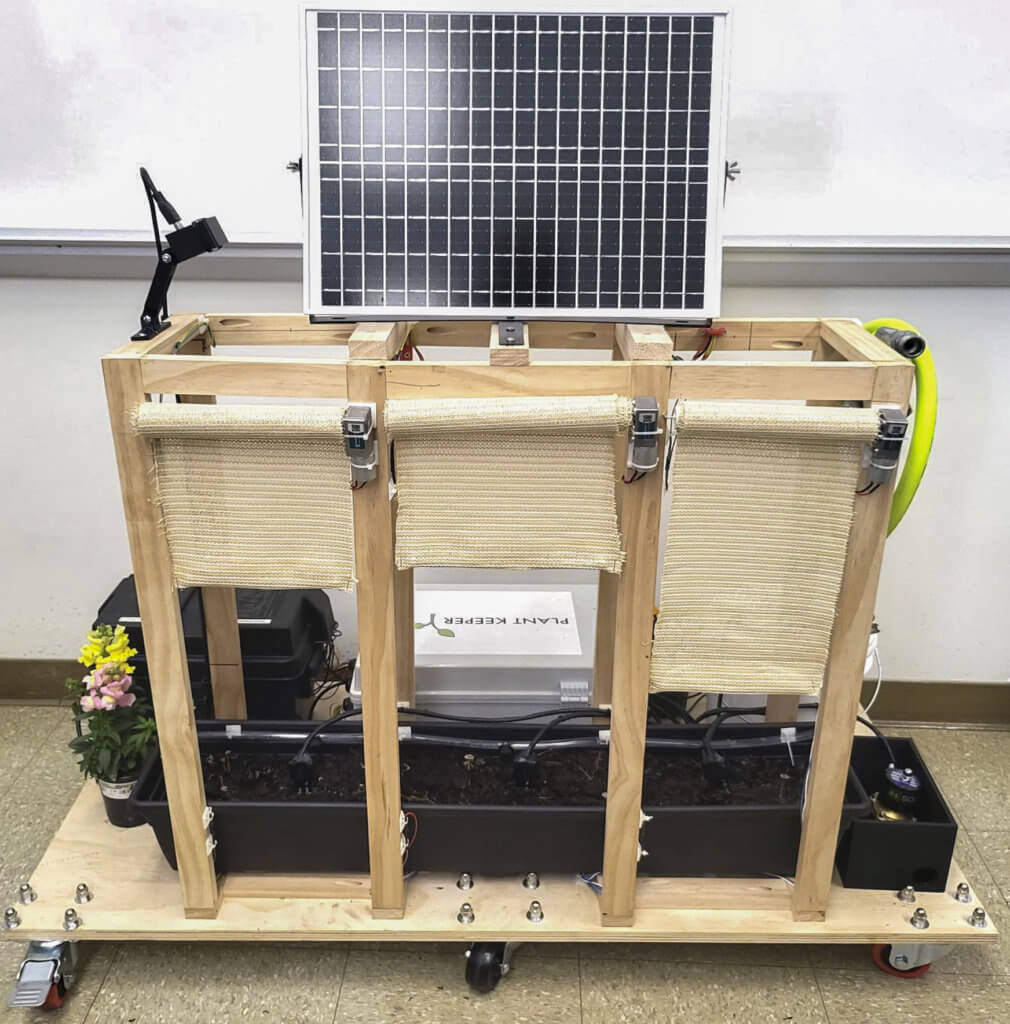
Civil engineering majors Isai Jimenez and Daniel Santa Maria are learning how to build a sustainable house for the future, focus on issues facing Orange County housing and reduce climate change impacts.
Through their hands-on project, the Cal State Fullerton seniors and their classmates are tackling critical aspects of construction, such as optimizing insulation, sealing, and heating and air conditioning systems to conserve energy. The future engineers also are finding ingenious solutions to build net-zero energy homes and water reuse systems to contribute to a more environmentally responsible future.
The Titan team will showcase their project at the Orange County Sustainability Decathlon Oct. 5-8 and Oct. 12-15. The inaugural event at the OC Fair and Event Center in Costa Mesa will feature university teams that designed and built sustainable housing prototypes to address California’s need for affordable housing and energy-efficient homes.
“The demand for resilient, sustainable and efficient infrastructure and communities has never been greater. The multidisciplinary nature of the decathlon has enabled our student team to create sustainable and environmentally friendly solutions,” said Susan Barua, dean of the College of Engineering and Computer Science. “Our students gained valuable practical skills, collaboration strengths, and knowledge aligned with addressing some of the biggest challenges facing our region.”
The CSUF students are immersing themselves in the California building code and current construction practices. More importantly, they are learning how to improve energy efficiency and water conservation. They are also focusing on cost-effective construction practices, said the team’s faculty adviser Phoolendra Mishra, chair and professor of civil and environmental engineering.
“In the near future, we anticipate sustainability playing a central role in the design and construction of housing. Engineers and scientists worldwide are actively developing innovative approaches to make housing more sustainable,” Mishra said. “These efforts aim to reduce environmental impact, enhance energy efficiency and bolster homes’ resilience to the challenges posed by climate change.”
Students from various disciplines, including business administration-marketing, arts, biological science and computer engineering majors, have participated in the project.
The project’s construction phase is now primarily handled by civil engineering majors. Students are receiving faculty guidance from Mishra; Kiran George, professor of computer engineering; and Huda Munjy-Ahmed, assistant professor of civil and environmental engineering. Jonathan Woodland, the college’s mechanical equipment technician, and technician Robert Wright also assist and mentor students.

Industry partners, including Southern California Edison, WSP, Brandow & Johnston and ENGEO, have donated to the project. Decathlon organizers also gave each college team $100,000 to help with building costs.
For over a year, more than 30 CSUF students have been actively formulating inventive solutions to various challenges, rigorously testing their concepts and refining their ideas. Mishra said this process offers students a unique and dynamic learning experience and equips them with the skills to think creatively and innovatively.
“It encourages them to break free from conventional paradigms and explore novel approaches to problem-solving, fostering a mindset that embraces out-of-the-box thinking,” Mishra added.
Jimenez’s team focused on minimizing air movement through the walls and diffusing water vapor.
“We aimed to retain as much heat or cool air within the house, depending on the season, but also protect the insulation from the elements like mold and pests,” Jimenez said. “Minimizing these losses reduces energy consumption since the air conditioning system doesn’t work as hard or as often. It’s a simple way of helping to reduce our carbon footprint.”
Santa Maria’s team is in charge of insulating the house using dense-packed cellulose insulation. Cellulose is a sustainable insulation material option since it is made up almost entirely of recycled paper and costs little to produce, Santa Maria explained.
“The key to this design was that a few portions of wood stretched from the outside frame to the inside frame. With a traditional wall, each 2×4 stud acts as a thermal bridge, allowing heat to bypass the insulation and enter the house. Still, with the double wall configuration, the middle layer of insulation ensures that the bridge is interrupted,” he said.

Under George’s guidance, his students, many of whom graduated in May, designed and developed four sustainable prototypes using innovative technologies for the sustainable house exhibit.
These include an automatic waste sorter, plant keeper, sink n’ save smart faucet and smart home leak detection system.
“Students develop a holistic understanding of sustainability principles, resource management, environmental impact assessment and the practical application of sustainable technologies,” said George, the university’s 2020 Outstanding Professor. “These experiences prepare them to contribute to developing more sustainable and eco-friendly housing options for the future.”
The key aspects that students learned when working on these prototypes include:
- Resource efficiency to minimize waste, water usage and energy consumption;
- Energy management to incorporate renewable energy sources, optimize energy consumption and reduce greenhouse gas emissions;
- Water conservation to address water-efficient fixtures and leak detection and reduce water wastage;
- Automation and control systems to include sensors, actuators and data analysis techniques to make informed decisions and improve efficiency and convenience; and
- Human-centric design that prioritizes the comfort and well-being of occupants and promotes a healthy lifestyle.
“Being part of the Orange County Sustainability Decathlon empowers students in their academic journey by offering a multifaceted learning experience that combines academic knowledge with practical skills, teamwork, innovation, and a strong sense of purpose in contributing to sustainable solutions for real-world challenges,” Kiran said.
Jimenez and Santa Maria agree.
“The idea of designing new products and learning to construct a house in different ways is rewarding,” Jimenez said. “Each team is tackling different fronts to build something together that we hope people can learn from — and assist in sustainable living.”
Santa Maria added that the project helped hone his leadership skills by learning methods and technologies to communicate ideas among a team.
“I think the most exciting part now is what we are building might someday be used to build sustainable houses across California.”